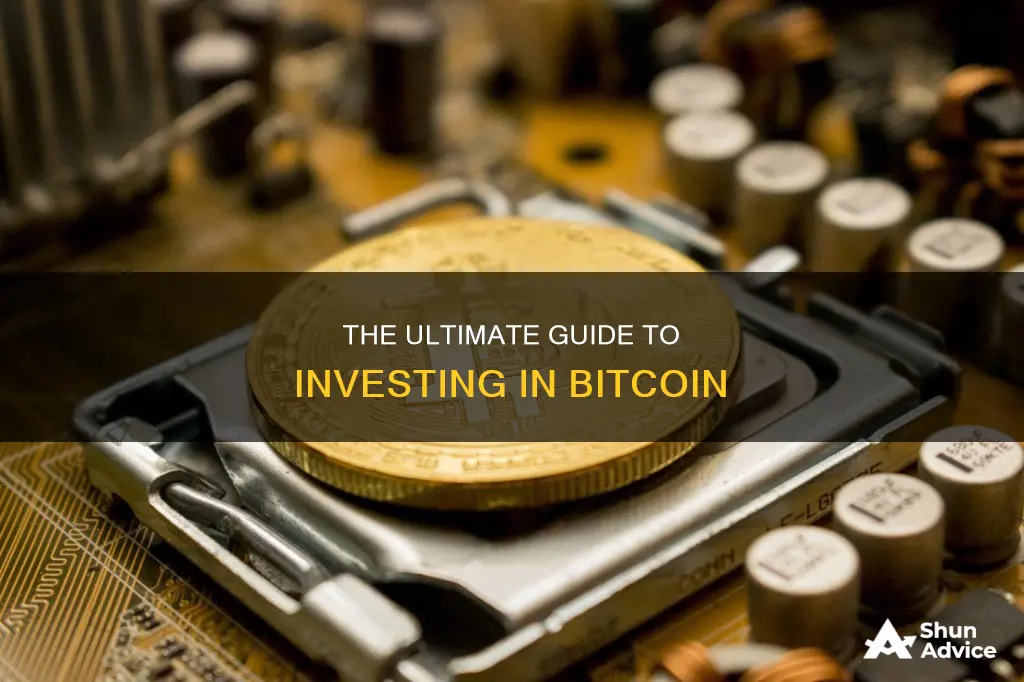
Investing in cryptocurrencies like Bitcoin has become increasingly popular in recent years, but it's important to understand the risks involved. Cryptocurrencies are digital currencies that generally operate outside the regulation of any individual company or government. They are often referred to as digital coins or tokens and are guarded by encryption through blockchain technology.
There are several ways to invest in Bitcoin:
1. Cryptocurrency exchanges: These platforms offer a range of cryptocurrencies and enable investors to buy, sell, and hold crypto. Examples include Coinbase, Kraken, and Binance.
2. Traditional stockbrokers: Some traditional brokers offer a way to buy and sell Bitcoin, such as Robinhood, Webull, TradeStation, and Fidelity.
3. Peer-to-peer money transfer apps: Cash transfer services like PayPal, Venmo, or Cash App allow users to purchase, store, send, and sell Bitcoin directly through their apps.
4. Bitcoin ATMs: These machines act like in-person bitcoin exchanges, allowing individuals to insert cash and use it to purchase bitcoin, which is then transferred to online wallets.
5. Bitcoin exchange-traded funds (ETFs): In January 2024, the Securities and Exchange Commission approved spot Bitcoin ETFs, which track the price of Bitcoin and can be traded over major exchanges.
6. Direct purchase: You can buy Bitcoin directly from certain payment processors or financial apps, such as PayPal, Robinhood, or Webull.
Before investing in Bitcoin, it's crucial to understand the risks and do your due diligence. Cryptocurrencies are highly volatile and susceptible to dramatic price swings. The market is also prone to fraud and security breaches, and investments are not always guaranteed or insured. It's recommended to only invest an amount you are willing to lose and to use secure storage methods, such as crypto wallets, to protect your assets.
| Characteristics | Values |
|---|---|
| How to buy Bitcoin | Via a cryptocurrency exchange, traditional stockbroker, money transfer app, Bitcoin ATM, or Bitcoin ETF |
| How to store Bitcoin | In a hot wallet (cloud-based) or cold wallet (portable device) |
| Risks | Very high-risk investment due to volatility, potential for pump-and-dump schemes, and lack of regulatory infrastructure |
| Other ways to invest in Bitcoin | Invest in companies with a focus on Bitcoin, a Bitcoin-focused fund, or a cryptocurrency Roth IRA |
What You'll Learn

Choosing a Bitcoin exchange
- Security and Authenticity: Conduct thorough research to ensure the exchange is legitimate and secure. Check its reputation, user reviews, and the security protocols they have in place to protect your data and funds. The presence of two-factor authentication (2FA) and cold storage options are good indicators of a secure platform.
- Payment Options: Different exchanges support various payment methods, such as bank transfers, PayPal, credit/debit cards, or other cryptocurrencies. Choose an exchange that aligns with your preferred payment method, especially if you're a beginner and need to enter the market with fiat currency.
- Supported Coins: While most exchanges support Bitcoin and Ethereum, consider whether you want exposure to other cryptocurrencies. Some exchanges, like Binance, offer a wider range of coins and tokens.
- Transaction Fees: Understand the fee structure of the exchange. Look for transparent platforms without hidden fees. Compare the fees across exchanges, as they can vary significantly.
- User Interface and Experience: Opt for an exchange with an intuitive and user-friendly interface. Check for good customer service and easy accessibility. A platform that offers educational resources and a smooth trading experience can enhance your overall user journey.
- Regulations and Compliance: Different exchanges operate under various laws and regulations based on their locations and practices. Consider your own location and ensure the exchange complies with relevant regulations, such as Know Your Customer (KYC) and Anti-Money Laundering (AML) practices.
- Volume and Liquidity: Assess the trading volume and liquidity of the exchange. Higher volume exchanges provide better liquidity, making it easier to enter or exit positions without significantly impacting the market price.
- Fiat Compatibility: If you plan to convert fiat currency (e.g., USD, CAD) into cryptocurrency, ensure the exchange supports your desired fiat options and works with compatible banks.
- Reputation and History: Research the exchange's reputation and history. Check for any past security breaches, hacks, or scams associated with the platform. Evaluate their transparency and track record in handling user funds and data.
- Advanced Features: If you're an experienced trader, consider exchanges that offer advanced features like margin trading, futures trading, and staking options. These features can provide additional opportunities for more sophisticated trading strategies.
Some popular Bitcoin exchanges include Coinbase, Binance, Kraken, Gemini, and Crypto.com. Each exchange has its own strengths and weaknesses, so be sure to review their features, fees, security measures, and supported coins before making your decision.
The Ultimate Guide to Bitcoin Investing
You may want to see also

Getting a Bitcoin wallet
Types of Bitcoin Wallets:
- Hosted wallets: These are the most popular and easy-to-set-up type of crypto wallet. When you buy crypto through an app, your cryptocurrency is automatically stored in a hosted wallet. A third party, such as an app, keeps your crypto for you, similar to how a bank keeps your money. The main benefit of a hosted wallet is that if you forget your password, you won't lose your crypto. However, a drawback is that hosted wallets may not support all the features available with other types of wallets.
- Non-custodial wallets: These wallets put you in complete control of your crypto. Non-custodial wallets don't rely on a third party to keep your crypto safe. While the wallet provider gives you the software to store your crypto, the responsibility of remembering and safeguarding your password or private key falls entirely on you. If you lose your private key, there is no way to access your crypto. Non-custodial wallets also allow you to access more advanced crypto activities like yield farming, staking, lending, and borrowing.
- Hardware wallets: Hardware wallets are physical devices, about the size of a thumb drive, that store the private keys to your crypto offline. They are considered one of the most secure methods to store large amounts of Bitcoin. However, they are more complex to use and can be costly, often upwards of $100.
Setting up a Bitcoin Wallet:
When setting up a Bitcoin wallet, it is important to consider the security, ease of use, and compliance with government and financial regulations. Here are some general steps to set up a crypto wallet:
- Choose a platform or wallet app that you trust.
- Create your account by entering your personal information and choosing a secure password. It is recommended to use two-factor authentication (2FA) for added security.
- Buy or transfer crypto to your wallet. Most platforms allow you to buy crypto using a bank account or credit card. If you already own crypto, you can transfer it to your new wallet.
It is important to note that Bitcoin can be stored in two types of wallets: hot wallets and cold wallets. Hot wallets are typically online or digital wallets, while cold wallets are offline storage methods such as hardware wallets. Hot wallets are generally faster for transactions, while cold wallets provide extra security for your Bitcoin but may make transactions take longer.
A Beginner's Guide: Investing in Bitcoin Gold
You may want to see also

Connecting your wallet to a bank account
Step 1: Choose a Cryptocurrency Exchange
Firstly, you'll need to select a cryptocurrency exchange platform that suits your needs. Popular options include Coinbase, Kraken, Gemini, and Crypto.com. These exchanges allow you to buy and sell various cryptocurrencies, including Bitcoin. Compare the fees, features, and consumer protections offered by each exchange before making your decision.
Step 2: Create an Account
Once you've chosen an exchange, sign up and create an account. This typically involves providing personal information, such as your name, email address, and setting up a password. Some exchanges may also require additional verification, such as a driver's license or other identification documents.
Step 3: Connect Your Bank Account
After creating your account, navigate to the settings or payment options section of the exchange platform. Look for an option to "Add a Payment Method" or "Connect a Bank Account." Provide the necessary details, such as your bank account number and routing number.
Step 4: Verify Your Bank Account
In some cases, you may need to verify your bank account before you can start using it for transactions. This process may vary depending on the exchange, but it typically involves a test deposit. The exchange will deposit a small amount into your bank account, and you'll need to confirm the amount received to verify the account.
Step 5: Buy Bitcoin
Once your bank account is connected and verified, you can start purchasing Bitcoin. Specify the amount you want to buy, ensuring you are aware of any associated fees. The purchased Bitcoin will be deposited into your cryptocurrency exchange account, which serves as a hot wallet.
Security Considerations:
When connecting your bank account to a cryptocurrency exchange, it's essential to prioritize security. Here are some key considerations:
- Two-Factor Authentication (2FA): Enable two-factor authentication for an extra layer of security. This typically involves providing your password and receiving a verification code via text or an authentication app.
- Strong Password: Use a strong and unique password for your exchange account. Avoid using easily guessable passwords or passwords that you've used on other accounts.
- Secure Internet Connection: When connecting your bank account or making transactions, ensure you're using a secure and private internet connection. Avoid using public Wi-Fi or accessing your account from a public computer.
- Monitor Transactions: Regularly review your transaction history and account activity. Report any suspicious activity immediately to your bank and the exchange platform.
- Backup Your Wallet: If you decide to transfer your Bitcoin to a third-party hot wallet or a cold wallet, ensure you back up your wallet regularly. This will help protect your funds in case of device loss or damage.
Remember, investing in Bitcoin and other cryptocurrencies carries risks. Always do your research, understand the fees involved, and consider the potential impact on your financial situation before investing.
Coinbase Bitcoin Investment: A Beginner's Guide to Getting Started
You may want to see also

Placing your Bitcoin order
Choose a cryptocurrency exchange:
Select a reputable and well-known exchange platform that offers a wide range of cryptocurrencies and has a large selection of currencies. Examples of popular exchanges include Coinbase, Binance, and Kraken.
Create an account:
Provide your personal information and verify your identity to complete the registration process. This usually involves submitting documents such as a government-issued ID and proof of address.
Fund your account:
Before buying any cryptocurrency, you need to deposit funds into your exchange account. You can fund your account using various payment methods, including bank transfers, credit/debit cards, or other cryptocurrencies.
Decide on the amount and type of order:
Determine how much Bitcoin you want to purchase. You can either buy a whole Bitcoin or a fraction of it, as many exchanges allow for fractional trading. Additionally, choose the type of order you want to place, such as a market order, limit order, or stop order. Each order type has its advantages and considerations:
- Market Order: This is the simplest type of order, where you buy or sell Bitcoin at the current market price. Market orders are executed instantly and are suitable for those who want immediate trades. However, you may not have control over the price you pay, and market orders cannot be cancelled once placed.
- Limit Order: With a limit order, you set a specific price at which you want to buy or sell Bitcoin. This order type allows you to buy/sell Bitcoin at your desired price or better. It gives you more flexibility with the price and amount but may not be executed if the specified price is not met.
- Stop Order: A stop order lets you trigger a buy or sell action when Bitcoin's price reaches a specified level, known as the stop price. This can help protect profits or limit losses. Stop orders can be combined with limit orders (stop-limit orders) for more advanced trading strategies.
Place your order:
Follow the steps provided by your chosen exchange to submit your buy or sell order. Review the order details, including the amount, price, and type of order, before finalizing the transaction.
Store your Bitcoin in a wallet:
Once you've purchased Bitcoin, you'll need to store it in a secure wallet. You can choose between a hot wallet, which is provided by an exchange or a third-party provider, or a cold wallet, which is an offline device specifically designed to store cryptocurrencies.
Remember to always do your research, understand the risks involved, and consult with a financial advisor if needed before investing in Bitcoin or any other cryptocurrency.
UK Guide: Getting Started with Bitcoin Investments
You may want to see also

Managing your Bitcoin investments
Once you've purchased Bitcoin, you'll need to consider how to manage your investment. Here are some key things to keep in mind:
Storing your Bitcoin
Bitcoin can be stored in a "hot wallet" or a "cold wallet". A hot wallet is connected to the internet and is typically provided by a cryptocurrency exchange or a third-party provider. It offers convenience but may be more vulnerable to hacking. A cold wallet is an offline storage device, similar to a USB drive, that provides an extra layer of security. Cold wallets are considered the safest option for storing large amounts of Bitcoin.
Security
Keeping your Bitcoin secure is critical. Use strong passwords, two-factor authentication, and secure internet connections to protect your Bitcoin wallet. Be vigilant about phishing scams and never share your password or private key with anyone.
Investment Strategies
There are different strategies for investing in Bitcoin, such as:
- Buy and 'Hodl': This strategy involves holding onto your Bitcoin for the long term, riding out the ups and downs of the market without selling.
- Long-Term Holding: Similar to the first strategy, but with the intention of selling once you're satisfied with the returns.
- Short-Term Trading: This strategy involves buying and selling Bitcoin over shorter periods, aiming to capitalise on short-term price fluctuations.
Diversification
Bitcoin is a high-risk, volatile asset. To manage your risk, consider diversifying your investment portfolio. Invest primarily in low-risk assets like government bonds or index funds, then consider medium-risk options like real estate or corporate stocks. Bitcoin and other high-risk investments should be a smaller part of your portfolio.
Regular Review
Regularly review your investment strategy and risk tolerance. Bitcoin's value can fluctuate dramatically, so it's important to stay informed about market conditions and adjust your investments as needed.
Schwab's Guide to Buying Bitcoin
You may want to see also
Frequently asked questions
You can buy Bitcoin through a cryptocurrency exchange, such as Coinbase, Binance, or Kraken. Alternatively, you can use a traditional stockbroker like Robinhood, or a peer-to-peer money transfer app like PayPal, Venmo, or Cash App.
A Bitcoin wallet is where you store your cryptocurrency. There are two types of wallets: a "hot wallet", which is provided by your crypto exchange or a third-party provider and can be accessed online, and a "cold wallet", which is an actual physical device that you can use to store and carry your Bitcoin.
The amount of money you need to invest in Bitcoin depends on the exchange you're using, but it can be a small amount—some crypto exchanges have minimum purchases of $10 or less, and you can buy fractions of a single coin.
Bitcoin is a very high-risk investment because it's a volatile asset. Its value may rise or fall dramatically in a very short period, and it's prone to "pump-and-dump" schemes. It's also important to note that Bitcoin and other cryptocurrencies are not insured or protected by government or financial institutions.







